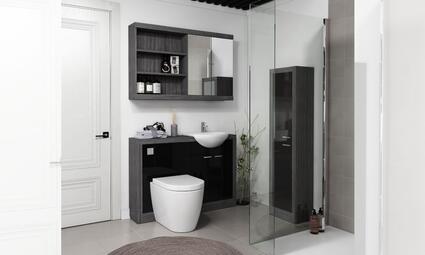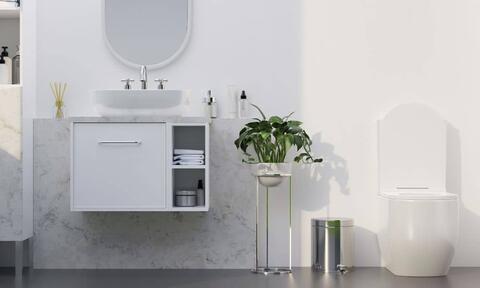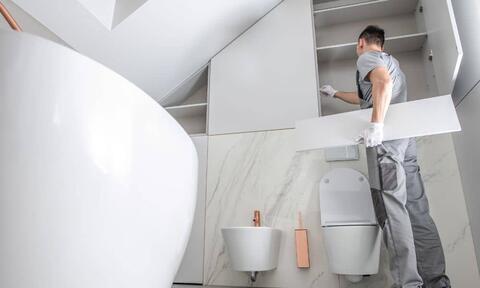
A new bathroom can impact your quality of life positively.
Gone are the days when a bathroom was only a practical room in a home. With sheer indulgence and relaxation in mind, people are intent on making the most of their scarce downtime these days.
Considering the endless innovations and extra features – think digital showers, whirlpool Jacuzzi baths, double sink vanity units, tallboy cabinets, and floor heating – one can integrate into a new bathroom, the choice on offer is easily overwhelming.
In this guide, you’ll learn the various intricacies involved in a new bathroom installation.
- Buying the Right Bathroom Products
- Choosing a Builder/Decorator
- Steps in the Bathroom Installation Process
- Step 1: Bathroom Layout Plan
- Step 2: Install Sanitary Piping and Plumbing Lines
- Step 3: Install Electrical Wiring
- Step 4: Fix the Countertop and Install the Bathtub and Shower Enclosure
- Step 5: Fix the Wall Tiles and Flooring
- Step 6: Paint the Walls and Ceiling
- Step 7: Install the Electrical Fixtures
- Step 8: Install the Sanitaryware
- Step 9: Fix All Other Bathroom Accessories and Door
- How Much Does It Cost to Install a New Bathroom in the UK?
- Labour Costs
- Buying a New Bathroom?
Navigate to any section of this post by clicking on the links above.
Buying the Right Bathroom Products
When it comes to bathroom installation, the first point to think about is the type of bathroom you want. Is it a family bathroom, guest bathroom, or bare-bones bathroom? Or do you plan to build an indulgent space to unwind?
The important design decisions will depend on who (and how many) will use the bathroom.
Your budget and the quality of fittings you want will determine the products you buy for your bathroom installation. If your budget is low, you can opt for fittings at a lower price range.
Likewise, you can buy higher-priced fittings that match your budget. Regardless of your budget, look for products that come with extended guarantees or warranties.
Choose materials carefully. For instance, if you love natural stone, don’t settle for ceramic tiles. The feel-good factor and overall harmony between the different elements are important in a bathroom. Hence, before you purchase any material, remember that you’ll have to live with it for several years.

Choosing a Builder/Decorator
Horror stories about builders and interior decorators abound. The most common complaints are poor quality of workmanship, half-finished projects, budgets spiralling out of control, and ending up paying more than the quoted price.
The first step is to evaluate the scope of the project. A new bathroom installation is definitely not a DIY job. Unless you are a skilled worker yourself, you can easily botch it up. And as a result, the project cost may rise further.
Engaging separate tradespersons such as plumbers, electricians, and plasterers is a good option. But hiring them all to work on your timeline is difficult. Even if you are successful, managing and coordinating the different skilled people on-site can be a huge challenge.
The best solution, therefore, is to hire a bathroom installation specialist. But approach a specialist only after you have the drawings ready. Make a list of all the fittings you want – and don’t want – to go along with your bathroom installation.
Hiring a single contractor to take care of the whole project may seem expensive. But due to the need to hire different skilled tradespersons to complete a new bathroom installation project successfully, it’s worth the cost.
Look for a professional who has great reviews on Trustpilot. The advantage of engaging the services of a professional is that even if you make a major change to the initial plan, they will be competent and flexible enough to deal with it.

Steps in the Bathroom Installation Process
The bathroom installation process will be simple if you follow the steps detailed here.
Step 1: Bathroom Layout Plan
Ensure optimal use of space by dividing the bathroom into distinct wet and dry zones. (You can ignore this stipulation if your bathroom is too tiny.) Allow sufficient space for movement inside the bathroom.
Determine the position of storage units, sanity fixtures, and radiator. Create a detailed electrical layout, marking the position of light points, switchboards, water heater, and exhaust fan.
Step 2: Install Sanitary Piping and Plumbing Lines
Mark the position of the toilet, shower, bathtub, and washbasin, and install the underground sanitary piping and plumbing lines to match these points.
Step 3: Install Electrical Wiring
Install electrical wires in accordance with the position of the exhaust fan, water heater, shaving point, mirror lights, ceiling lights, floor heating, etc.
Step 4: Fix the Countertop and Install the Bathtub and Shower Enclosure
The dimensions of the countertop should match the proposed design. Some common countertop materials include solid surface, engineered quartz, granite, and marble.
Other tasks in this bathroom installation step include fixing the bathtub and shower enclosure frame.
Step 5: Fix the Wall Tiles and Flooring
Fix the skirting and wall tiles in accordance with the proposed design. If you are opting for floor heating, fix the floor heating mat before installing the flooring. Keep in mind the recommended slope for quick water drainage. Seal the gap between tiles with grout after the tiles dry.
Step 6: Paint the Walls and Ceiling
If the wall surface is not entirely tiled, you can paint it with moisture-resistant paint. Choose colours that complement the other design elements.
Step 7: Install the Electrical Fixtures
Install the switchboards, water heater, digital shower, lights, exhaust fan, etc. Check if the connections to the exhaust fan, water heater, shaving point, mirror lights, ceiling lights, etc., are working alright.
Step 8: Install the Sanitaryware
Install the sink, commode, vanity unit, and other bathroom furniture. Install sanitary fittings such as bath taps, handheld shower, overhead shower, washbasin taps, etc.
Step 9: Fix All Other Bathroom Accessories and Door
In this final bathroom installation step, fix the glass panels of the shower enclosure. Also, fix the other essential accessories such as toilet paper holder, towel racks, robe hooks, soap dispenser, soap tray, and mirror cabinet. Fix the bathroom door.
The new bathroom is ready!
How Much Does It Cost to Install a New Bathroom in the UK?
A new bathroom installation will cost anywhere between £5,000 and £10,000, depending on the type of bathroom you want to build. If your budget is on the lower end, you can install only the basic accessories, such as a washbasin, toilet, and mirror cabinet.
You can install pricier accessories, such as a bathtub, shower enclosure, vanity unit, floor heating, etc., if your budget is mid-range (say between £4,000 and £6,500), But if you have set your mind on a luxury bathroom, you’ll need to shell out anywhere between £8,000 and £10,000 for a designer suite with Jacuzzi bathtub, natural stone wall tiles, digital shower, and high-end mixer taps.
Bathroom fittings and fixtures are available in a wide price range. The table below indicates the rates for different furniture/ fittings:

Labour Costs
The labour costs will depend on the size of your bathroom. A big bathroom is more expensive compared to a small one as it needs more materials and time to complete. More fittings and electrical points also mean higher costs.
A bathroom fitter will cost anywhere between £150 and £250 per day. The cost will vary depending on the nature of the work. You’ll need at least two labourers, and the project will take 3 to 7 days to complete.
A plasterer charges between £400 and £700 per day. Plastering requires applying building material that coats and safeguards interior walls and ceilings. The labour costs for plastering will be around £450 for a small bathroom, £550 for a medium-sized bathroom, and £700 for a large-sized bathroom.
The labour cost for tiling is the major component of a new bathroom installation project. Hence, it’s wise to begin budgeting for bathroom tiling early.
A tile setter charges £300 per day. Tile installation covers laying hard-wearing natural stone, ceramic, porcelain, or glass tiles to cover the countertop, floors, and walls. The tiling costs for a bathroom will be around £50m2 for tiles.
The cost variation is high because it’s dependent on the materials you use, the design you choose, and the size of your bathroom. Likewise, the tiling costs for a mid-sized bathroom will be around £1,100–£2,700 and £2,200–£4,750 for a large bathroom.
Buying a New Bathroom?
At Bathroom City, you’ll find pre-selected matching bathroom suites and furniture that will make your task of new bathroom installation that much easier. Founded in 1986, we’re one of UK's oldest online Bathroom Furniture Specialists.
You can buy every accessory you’ll need for a contemporary bathroom at our store. The prices of smart tech gadgets such as smart showers, automatic sensor taps, floor heating systems, and smart thermostats are also dropping. So now is the best time to add them to your new bathroom.
Other related articles you might also like to read: